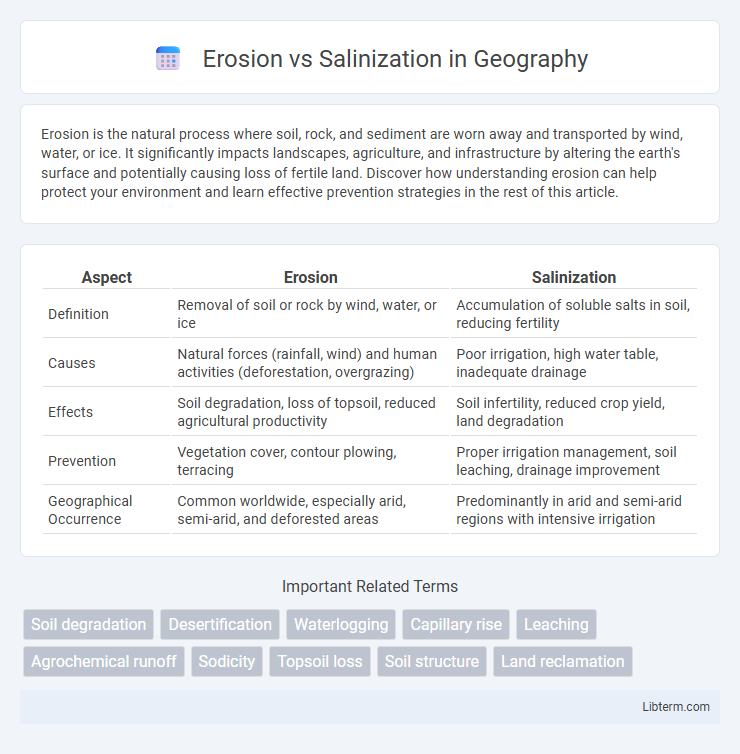Erosion is the natural process where soil, rock, and sediment are worn away and transported by wind, water, or ice. It significantly impacts landscapes, agriculture, and infrastructure by altering the earth's surface and potentially causing loss of fertile land. Discover how understanding erosion can help protect your environment and learn effective prevention strategies in the rest of this article.
Table of Comparison
| Aspect | Erosion | Salinization |
|---|---|---|
| Definition | Removal of soil or rock by wind, water, or ice | Accumulation of soluble salts in soil, reducing fertility |
| Causes | Natural forces (rainfall, wind) and human activities (deforestation, overgrazing) | Poor irrigation, high water table, inadequate drainage |
| Effects | Soil degradation, loss of topsoil, reduced agricultural productivity | Soil infertility, reduced crop yield, land degradation |
| Prevention | Vegetation cover, contour plowing, terracing | Proper irrigation management, soil leaching, drainage improvement |
| Geographical Occurrence | Common worldwide, especially arid, semi-arid, and deforested areas | Predominantly in arid and semi-arid regions with intensive irrigation |
Understanding Soil Erosion
Soil erosion is the process by which topsoil is removed by natural forces such as wind, water, or human activities, leading to loss of soil fertility and reduced agricultural productivity. Unlike salinization, which involves the accumulation of soluble salts in soil, erosion primarily affects soil structure and nutrient content by physically displacing soil particles. Key factors influencing erosion rates include rainfall intensity, soil type, vegetation cover, and land management practices, emphasizing the importance of sustainable soil conservation techniques to prevent land degradation.
What is Salinization?
Salinization is the accumulation of soluble salts in soil layers, adversely affecting soil fertility and crop productivity. It primarily occurs due to improper irrigation practices, poor drainage, and high evaporation rates, leading to the concentration of salts near the root zone. This process contrasts with erosion, which involves the physical removal of topsoil by wind or water rather than chemical changes in soil composition.
Causes of Erosion
Soil erosion primarily occurs due to natural factors such as rainfall intensity, wind velocity, and slope gradient, which dislodge and transport topsoil particles. Human activities including deforestation, overgrazing, and improper agricultural practices exacerbate erosion by reducing vegetative cover and disturbing soil structure. These causes collectively lead to the loss of fertile soil, reduced agricultural productivity, and increased sedimentation in water bodies.
Causes of Salinization
Salinization primarily results from improper irrigation practices that lead to the accumulation of soluble salts in the soil. High evaporation rates in arid and semi-arid regions concentrate these salts near the soil surface, deteriorating soil quality. Poor drainage further exacerbates salt buildup, impairing plant growth and reducing agricultural productivity.
Key Differences Between Erosion and Salinization
Erosion involves the physical removal of topsoil by wind, water, or human activity, leading to loss of fertile land and decreased agricultural productivity. Salinization, on the other hand, results from the accumulation of soluble salts in soil, often due to improper irrigation practices, which impairs plant growth by disrupting water uptake. While erosion primarily affects soil structure and depth, salinization alters soil chemistry, making these two processes distinct yet equally detrimental to soil health.
Environmental Impacts of Erosion
Erosion causes significant environmental impacts by removing topsoil, reducing soil fertility and disrupting plant growth, leading to decreased agricultural productivity. It increases sedimentation in waterways, which harms aquatic ecosystems, reduces water quality, and alters natural habitats. Furthermore, erosion destabilizes land, increasing the risk of landslides and contributing to the loss of biodiversity in affected areas.
Effects of Salinization on Agriculture
Salinization significantly reduces soil fertility by increasing salt concentrations, which impairs water absorption and nutrient availability for crops, leading to decreased agricultural productivity. High salinity stresses plants, causing stunted growth, leaf burn, and lower yields, particularly in salt-sensitive crops such as rice and wheat. Over time, salinized soils may become unsuitable for cultivation, forcing farmers to abandon lands and resulting in economic losses and food security challenges.
Prevention and Management Strategies
Erosion prevention relies on strategies like contour plowing, terracing, and maintaining vegetation cover to reduce soil loss and enhance water retention. Salinization management involves proper irrigation practices, such as using high-quality water and implementing drainage systems to prevent salt accumulation in the soil. Both processes require integrated land management approaches, including crop rotation and soil amendments, to sustain soil health and agricultural productivity.
Case Studies: Erosion vs Salinization
Case studies reveal erosion primarily affects topsoil loss in regions such as the Midwest United States and the Loess Plateau in China, resulting in decreased agricultural productivity and increased sedimentation in waterways. Salinization cases, notably in Australia's Murray-Darling Basin and India's Indo-Gangetic Plain, demonstrate soil salt accumulation caused by improper irrigation and poor drainage, leading to reduced crop yields and land degradation. Comparative analyses highlight erosion's immediate impact on soil structure versus salinization's long-term chemical soil quality decline, emphasizing tailored land management strategies for each issue.
Sustainable Solutions for Soil Health
Erosion and salinization are critical threats to soil health that require sustainable management practices to ensure long-term productivity. Techniques such as contour plowing, cover cropping, and maintaining vegetation buffers reduce soil erosion by protecting topsoil from wind and water forces. Addressing salinization involves proper irrigation management, soil drainage improvement, and the use of salt-tolerant crops to prevent salt accumulation and preserve soil structure.
Erosion Infographic

 libterm.com
libterm.com